 Image search results - "wing" Image search results - "wing" |

Three-day (Aug. 9-11, 2006) rowing route around the southern half of the lake by the Kyoto Univ. rowing club.1st day: Home base in Seta River to Manohama (crew change), then to Omi-Maiko.
2nd day: Omi-Maiko to Manohama, then to Chomeiji.
3rd day: Chomeiji to Manohama where crew changes. Then to home base in Seta River.
|
|

Three boats are used for the trip, sighted here off shore near JR Hira Station on the Kosei Line. 湖西線比良駅の沖
|
|

Well-wishers look on as rowers embark for the race taking place at the same venue where the rowing competition was held at the 1964 Tokyo Olympics.
|
|
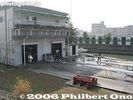
Seta Rowing Club's 2-story clubhouse located in Otsu, Shiga Prefecture. The club is a registered NPO. The club is named after Seta River at the southern tip of Lake Biwa. Regattas are also held on the river, Lake Biwa's sole outflowing river.
|
|

PR poster designed by Tetsuo OshiroPoster for the race.
京都大学ボート部OBの尾城徹雄様に作成したポスター。大学内や大津市石山商店街などで張り出された。
|
|

Being my first regatta, I was at first daunted by the rowing terminology for the different types of boats.
|
|

Arriving Omi-Maiko on Day 1. Rowing around the lake has been an annual tradition.
|
|

Finish line end of the 2000-meter Toda Boat Course.
|
|

Seta Rowing Club's clubhouse. Boats are stored on the bottom floor, while the 2nd floor has office space, ergo machines, meeting room, locker room, etc. Web site here
|
|

Carrying back a single sculling boat
|
|
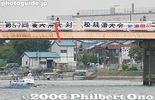
Karahashi Bridge as the starting point for alumni races
|
|
|

End of the Toda Boat Course, near the 2000-meter finish line.
|
|
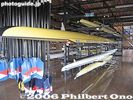
Oars and boats stored on the bottom floor. The club offers 2-hour rowing lessons on Sundays during May to Nov. Address: 6-1 Ogaya, Otsu, Shiga 520-2144 Japan. Phone/Fax: 077-545-9961, Email: info@setarc.jp
|
|

The place was not as crowded as you would think.
|
|

They use four-man boats (called "knuckle four" in Japanese) with sliding seats. It is stable and safe, ideal for beginners.
|
|

Housing for visiting rowing teams whose school flags are displayed.
|
|

Many boats are made in Italy.
|
|

To mark the song's 100th anniversary, a new song monument was unveiled at Kyoto University (Yoshida-South Campus) on Nov. 25, 2017.
|
|

Rowing team from Nagahama
|
|

Kyoto Univ. in dark blue T-shirts
|
|

Each boat has four rowers and cox who steers the rudder.
|
|

Boat landing near finish line.
|
|
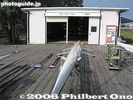
Right across the clubhouse is the Annex boat house.
|
|

Front side of the monument has the Japanese lyrics and explanation of the song. Monument is made of stainless steel with a brushed-metal finish.
|
|
|

The green boat. 近江舞子上陸
|
|

Hosei Univ. cheering section on the first day (Aug. 24, 2006) of the 33rd All-Japan Intercollegiate Rowing Championships.
|
|
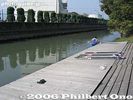
Club's boat dock. This narrow canal leads to Lake Biwa.
|
|
|

Azaleas in full bloom along the lake edge
|
|

Finish line 300 meters later
|
|

The boats are wooden, and a few decades old.
|
|

第33回全日本大学選手権大会・第46回オックスフォード盾レガッタ
|
|
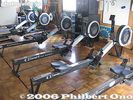
Rowing exercise machines called "ergometers" or "ergo" or "indoor rower." In Japan, they call it "ergo." エルゴThe machine measures the energy you expend rowing. Also measures how fast and far you rowed if you were on water. They even have ergo rowing contests which is a sport itself.
|
|
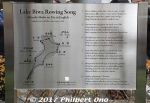
Monument's English side has a bilingual Lake Biwa map and Lake Biwa Rowing Song English lyrics.Directions: From JR Kyoto Station's Karasuma side (north side with Kyoto Tower), go to bus stop D2 and catch the No. 206 bus bound for "Gion Via Kiyomizu-dera Temple/Kitaoji Station" (三十三間堂・清水寺・祇園・百万遍). The bus leaves every 15 min. or so (bus schedule here), but it can be very crowded. The ride takes abut 30 min. Get off at "Kyodai Seimon-mae" (京大正門前). Cross the big road (Higashi-Oji-dori) and walk along Higashi-Ichijo street. The main Yoshida Campus will be on the left while the Yoshida-Minami Campus will be on the right. Enter the Yoshida-Minami Campus and walk to the central courtyard area.
(From Kyoto Station, there is also an express bus (京大快速) to Kyoto University Hospital from bus stop D3, but it runs only at certain times on weekdays, mainly in the morning and mid-afternoon (bus schedule here).
|
|
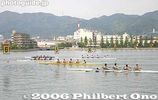
Four-man boat race. There were also foreign rowers from international schools.
|
|

Tokyo Univ. (Todai) crew return to land after a race
|
|

Notice the rudder. Controlled by a pair of strings held by the cox.
|
|

Numerous college and corporate rowing clubs have dormitories along the boat course.
|
|
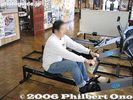
The rowing lesson starts with an ergo workout.
|
|

Cheering section for Nagahama
|
|
|

Beachgoers frolick in the lake as the rowing boats arrive.
|
|

Notice board for the race schedule and results.
|
|
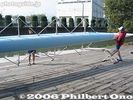
Carrying the boat.
|
|

About the song and rowing route... この歌について(日本語解説)Shiga Prefecture's most famous and beloved song is called Biwako Shuko no Uta (琵琶湖周航の歌) or "Lake Biwa Rowing Song." I have rendered this song into both pictures and English, according to my own imagination and interpretation.
Please see this page for a full explanation: https://photoguide.jp/txt/Lake_Biwa_Rowing_Song
First composed in 1917 by a bunch of college students from Kyoto, the song has been recorded by many famous Japanese singers and groups. In 1971, it became a major nationwide hit with singer Tokiko Kato's rendition. Today, the song remains a favorite among choir groups in Japan, and a choir singing contest is held for the song every June (since 1997) in Imazu, the birthplace of the song in the northwestern corner of Lake Biwa.
Shiga Prefecture also has stone monuments dedicated to each of the six verses. There's even a museum (Biwako Shuko no Uta Shiryokan) in Imazu dedicated to the song. Okaya city on the shores of Lake Suwa in Nagano Prefecture, the birthplace of the song's composer, Taro Oguchi (小口太郎) (1897-1924), also has a song monument and bronze statue of him.
|
|

Otsu Exhibition, Nov. 21 - Dec. 4, 2005 at Shiga Kaikan, Otsu, Shiga. Right across from the Shiga Prefectural Office. 滋賀会館For this exhibition, I created my own photographic rendition of the places and scenes mentioned in the song and also photographed all the stone monuments dedicated to the song. I used Photoshop to composite images and to alter the colors into a dreamy condition as the song suggests. I also translated the lyrics into English.
The exhibition was held at Shiga Kaikan, right across from the Shiga Prefectural Office. Shiga Kaikan has two spaces for exhibitions, and I used the smaller space called Bunka Salon Gallery.
Map: http://www.shiga-bunshin.or.jp/shigakaikan/map.html
Address: Kyomachi 3-4-22, Otsu, Shiga Pref.
Phone: 077-525-9995
〒520-0044 大津市京町三丁目 4-22
Web site: http://www.shiga-bunshin.or.jp/shigakaikan/
|
|
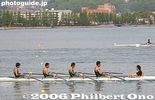
Four-man race with the cox at the stern
|
|

Verse 1 Song Monument, Otsu (Mihogasaki). In 1973, this was the first monument built for the song. The song's first and most famous line, "Ware wa Umi no Ko" is written. 一番の歌碑。大津市三保ケ崎。This monument is near the boat house in Mihogasaki, a stone's throw from Hama-Otsu.
われは湖の子 さすらいの
旅にしあれば しみじみと
のぼる狭霧や さざなみの
志賀の都よ いざさらば
Ware wa Umi no Ko, sasurai no
tabi ni shiareba, shimijimi to
Noboru sagiri ya, sazanami no
Shiga no Miyako yo, iza saraba
|
|

On June 16, 2007, Imazu marked the 90th anniversary of the song by organizing a boat cruise on Lake Biwa and other events. Omi-Imazu Station had a sign directing guests to Imazu Port. 90周年の記念「琵琶湖周航クルーズ」の近江今津駅内
|
|

The orange boat. On the left at the ear is the cox, the middle are four rowers, and at the front of the boat is one extra person who can rest and enjoy the ride.
|
|

On July 29, 2007, this regatta was held for the second time. It targets mainly beginner rowers. Organized by the Seta Rowing Club which seeks to have more people enjoy water sports on Lake Biwa. Seta-Karahashi Bridge was the regatta's starting line. The Lake Biwa Rowing Song CD was awarded to all the 1st, 2nd, and 3rd place winners in all five categories.
|
|

View from the spectator stand, near the finish line.
|
|

Sleek rudder and steering cables
|
|

Front of Yoshida Chiaki's home in Niigata (formerly Niitsu) which I visited in Nov. 2007. Yoshida Chiaki composed a song called "Hitsuji-gusa" (Water Lilies) whose melody was used for the song "Biwako Shuko no Uta" (Lake Biwa Rowi
|
|

Starting line. The man says "Yoi" (Ready) then "Go."「用意」、次いで「ゴー」
|
|

Univ. of Tokyo alumni crew in light blue T-shirts
|
|

Imazu Port. A large crowd of people waiting to board the chartered boat for a 3-hour cruise on Lake Biwa to commemorate the 90th anniversary of the song, Biwako Shuko no Uta.
|
|

Most people were oblivious to the boats.
|
|

Sixty rowing teams (300 people) rowed in five categories, including beginner and expert rowers, ranging in age from junior high to senior citizens.
|
|

Rowers reach the finish line after 2,000 meters.
|
|
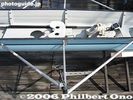
Rowing seat with moving seat on rails, fixed shoes, and outrigger for the oar.
|
|
|
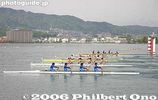
Four-man race starts with the cox at the front.
|
|

The photo above shows part of the stone monument for the first verse of the song. It reads "Ware wa Umi no Ko" (We're children of the lake). [url=http://photoguide.jp/txt/Lake_Biwa_Rowing_Song]More info about Lake Biwa Rowing Song here.[/uThis is the song's first and most famous line. The monument is in a small park near the former boathouse in Mihogasaki pier. The photo has been digitally altered (the colors are not real).
I visited and photographed all the places mentioned in the song as well as all the song monuments in Otsu, Omi-Maiko, Imazu, Chikubushima, Hikone, Chomeiji, and Okaya (Nagano). I also created some digital images to match the scenes mentioned in the song.
|
|

Title: Lake Biwa Rowing Song - In Pictures and in English Bunka Salon Gallery (also a coffee shop) inside Shiga Kaikan. 「琵琶湖周航の歌」〜写真と英語に〜The title was "Lake Biwa Boating Song - In Pictures and in English." I later changed the song title to "Lake Biwa Rowing Song."
Shiga Kaikan has two spaces for exhibitions, and I used the smaller space called Bunka Salon Gallery.
One entire wall and half of another wall were available for exhibitions free of charge.
|
|

Kyoto Univ. alumni crew in dark blue T-shirts
|
|

The "Rio Grande" cruise boat awaits at Imazu Port on a miraculously sunny day during the rainy season. 梅雨でありながら、奇跡的にこんないい天気になった。今津港
|
|

This is the boat dock where people got on and off the boats. The boats were provided by local rowing organizations. The regatta was organized by the Seta Rowing Club in Otsu.
|
|

The surroundings are not very scenic, and the water is not so clean.
|
|
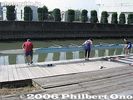
Carrying the boat to water.
|
|

Front gate of Yoshida Chiaki's home
|
|

My first and very small exhibition to introduce "Lake Biwa Rowing Song" in English. The English lyrics were still unfinished, so only an English translation was presented.I showed three images per verse (6 verses total), plus caption sheets and artist's message, boating map, and composer's biography on the other wall.
All the pictures were printed on A4 inkjet paper. Very low budget exhibition, but it caught the interest of one newspaper reporter. I later changed the song title to "Lake Biwa Rowing Song."
Exhibition Date & Time: Nov. 21 to Dec. 4, 2005, 9:30 am to 5:00 pm, closed Mon.
Map: http://www.shiga-bunshin.or.jp/shigakaikan/map.html
Address: Kyomachi 3-4-22, Otsu, Shiga Pref.
Phone: 077-525-9995
〒520-0044 大津市京町三丁目 4-22
Web site: http://www.shiga-bunshin.or.jp/shigakaikan/
|
|

Off they go
|
|

Kyoto Univ. alumni crew at start line
|
|

Priests in setsubun procession within the temple grounds.
|
|

Reception desk for passengers. A little over 100 people joined the cruise. クルーズの受付
|
|

The orange boat decided to go ashore where it was less crowded.
|
|

A rowing team leaves the dock for Seta-Karahashi Bridge seen in the background.
|
|

Kyoto Univ.
|
|
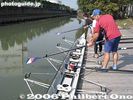
Inserting the oars into the outriggers.
|
|

Inner garden. I met Yoshida Yuki (吉田ゆき), the niece of Yoshida Chiaki who showed me the house and a few materials. Flowers planted by Chiaki still grow in the garden.
|
|

For each verse (total 6 verses), I showed three photos and a caption sheet with my non-singable English translation of the verse.「琵琶湖周航の歌」をイメージ写真付きで英訳された作詞と英文説明で紹介する写真展です。歌に登場する各地の写真や6番まですべての歌碑も英語で紹介。外国人も知って欲しい名曲です。英語の勉強にも!
2005年11月21日(月)〜12月4日(日) 9:30〜17:00
滋賀県大津市 滋賀会館 文化サロンギャラリー 入場無料
〒520-0044 大津市京町三丁目 4-22
Tel: 077-525-9995
HP: http://www.shiga-bunshin.or.jp/shigakaikan/
アクセス:
JR大津駅びわ湖口(北口)から徒歩5分
京阪浜大津駅からバス7分
名神大津インターからバス5分
京阪島ノ関駅から徒歩3分
1971年に加藤登紀子の大ヒットになったこの「琵琶湖周航の歌」は、昨年までに僕は聞いたことない。昨年の春に長野県諏訪市の御柱祭りを見に行ったときに岡谷市に泊まって近くの諏訪湖で散歩すると歌の作詞家である小口太郎(岡谷出身)の銅像があって「琵琶湖周航の歌」が紹介されて非常に興味深いものと思った。
英語で紹介したいなと思ってこの歌の英語版とイメージ写真をやっと完成しました。そしていつかこの歌を英語で歌ってもらいたい。歌詞を英語にすることはあまり難しくないが、それを歌のメロディに合わせることが大変。まだそこまで完成していない。もっと時間が必要。できあがったら、勿論また発表します。
この文化サロンは、サロン形の喫茶店になっている。
|
|
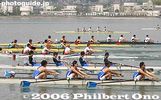
Close-up of rowers at Asahi Regatta
|
|

"Umi no Ko" (Child of the Lake) Lake Biwa training boatThe bow of Shiga Prefecture's "floating school." The name of this boat was obviously taken from the song. The boat is owned by Shiga Prefecture and used to educate elementary school kids about the lake. Since 1983, this ship has been serving as a floating school for kids where they stay overnight and spend two days conducting experiments to learn more about the lake. Picture was taken at Hikone Port.
|
|

Back of Verse 1 Song Monument, Otsu (Mihogasaki)Directions: From JR Otsu Station, take a bus to Mihogasaki. It's about 10 min. Or you can easily walk it from Hama-Otsu Station. Just walk on the main road toward the race boat arena. There will be a small marina on the right. Right after passing the marina, turn right into the small road. There will be a small park on the right. The monument is there. There are two stone monuments. It might be roped off and you're not supposed to enter the park. While you're there, walk around the marina and see the boathouse with the cherry blossom logo with three stripes. That's the logo of the school and the place where the boys left for the rowing trip in 1917. Otsu Station also has a tourist information office where you can obtain directions and a map.
|
|

On Karahashi Bridge
|
|

Priests in setsubun procession within the temple grounds.
|
|

Boarding time at Imazu Port. In the forefront is a song monument for Biwako Shuko no Uta.
|
|

Two boats will lie here overnight.
|
|

Seta-Karahashi Bridge, the start line.
|
|

Kyoto Univ.
|
|
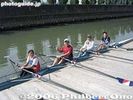
Ready to row on a "quad" sculling race boat. Each person rows with two oars.Sorry for the small image.
|
|

Yoshida Chiaki's room on the 2nd floor.
|
|

Verse 1 photos (Otsu)
|
|

Cheering section
|
|

Race starts for Kyoto Univ. alumni
|
|

Priests in setsubun procession coming through Niomon Gate
|
|

Megan and Jamie Thompson about to board the boat. トンプソン姉妹
|
|

Dark Blue Blades, symbol of the Kyoto Univ. rowing club.
|
|

Up to four rowing teams raced down a 250-meter straight course.
|
|

Preliminary heats were held on the first day.
|
|
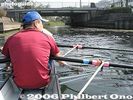
We now enter Lake Biwa.
|
|

Yoshida Chiaki's room on the 2nd floor. This is where he spent his final days while stricken with tuberculosis.
|
|

Verse 2 photos (Omi-Maiko)
|
|

High school spectators near the finish line
|
|

"Umi no Ko" (Child of the Lake) Lake Biwa training boat for kids
|
|

Near the Verse 1 Song Monument is another stone monument engraved with the words of the entire song.
|
|
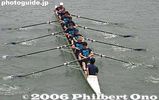
Kyoto Univ. alumni
|
|

Priest blowing a conch shell
|
|

Boat name "Rio Grande" operated by Biwako Kisen. Named after Shiga's sister state in Brazil. There is also the "Michigan" paddlewheel boat named after Shiga's sister state in the USA.
|
|

Oars and boats
|
|
|

Coach with megaphone
|
|
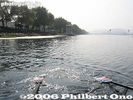
Lake Biwa Rowing Course operated by Shiga Prefecture for major rowing regattas. It is near the head of Seta River, and very near Seta Rowing Club.
|
|

View from Yoshida Chiaki's room on the 2nd floor. Sometimes they receive local school children for tours of the house.
|
|

Verse 3 photos (Imazu)
|
|

Kyoto University's cheering section for the 8-man raceComplete with cheerleaders.
|
|

Kyoto Univ. starts to veer off course
|
|

Priests in setsubun procession coming through Niomon Gate
|
|

Inside the front of the Rio Grande boat. 琵琶湖周航クルージング
|
|

Day 3: Arrival at Manohama beach, near the west end of Biwako Ohashi Bridge. 真野浜上陸
|
|
|

Kyoto Univ.
|
|
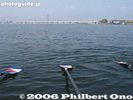
Oars keep the unstable boat stable.
|
|

Stairs from Yoshida Chiaki's room on the 2nd floor.
|
|

Verse 4 photos (Chikubushima)
|
|

Eight-man race
|
|

Small park where the Verse 1 monument is located.This monument is near the boat house in Mihogasaki, a stone's throw from Hama-Otsu. It was built in 1973 as the first monument for the song.
This little park is actually off-limits and you're not supposed to enter it, for some reason. On the left side of the picture is another stone monument hidden by brush. It is engraved with the entire song. In the background, you can see the roof of the boathouse.
|
|

Kyoto Univ. is unable to correct their misdirection
|
|

Festival beauties included.
|
|

Open deck at the rear. The boat departed at about 11:30 am.
|
|

Manohama is where they change boat crews. Half of the people ride on bicycles on shore, while the other half row on 3 boats.
|
|

All the boats are held stationary with a rope provided from the bridge.
|
|

Exhausted rowers at finish line.
|
|

The oar handles overlap when you pull them. Often my hands bumped into each other.
|
|

Original copy of the magazine "Ongaku-kai" (The Musical Japan) where Yoshida Chiaki's song "Hitsuji-gusa" was first published and made popular. Issued in Aug. 1915. 音楽界
|
|

Verse 5 photos (Hikone)
|
|
|
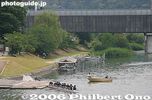
A faulty rudder runs them aground
|
|

Temple priest
|
|

We passed by various scenic spots such as Shirahige Shrine, noted for the torii gate in the lake.
|
|

Landed in fishing lines.
|
|
|
|

Winners of the preliminary heats advanced to the semi-finals held on the 3rd day (Aug. 26).
|
|
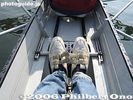
Shoes are fixed to a small, angled platform.
|
|

Table of Contents of magazine "Ongaku-kai" (The Musical Japan) 音楽界. Many music-related articles.
|
|

Verse 6 photos (Chomeiji)
|
|

Kyoto Univ. comes in 3rd place
|
|
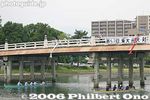
4-man crew alumni boat race
|
|

Names of the bean throwers.
|
|

Shirahige Shrine 白髭神社
|
|

Departing Manohama at about 11:30 am. 真野浜出発
|
|
|
|

On the first page is Yoshida Chiaki's song "Hitsuji-gusa" (Water Lilies) which was acclaimed enough to be published here.
|
|
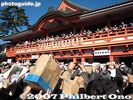
Start of setsubun bean throwing (mamemaki) by minor celebrities. 豆まき
|
|

On the adjacent wall, I showed a map of the rowing route, artist's message in English and Japanese, and an English biography of Taro Oguchi, the songwriter.
|
|
|
|
|
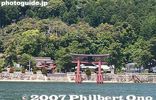
Shirahige Shrine torii as seen from the cruise boat.
|
|

Small motorboat which accompanies the three rowing boats. I was aboard this motorboat and took pictures.
|
|
|

The race course is filled with boats on the side practicing or rowing to the starting line.
|
|
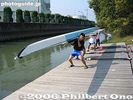
After a neat rowing trip, the boat is lifted out of the water.
|
|

On the first page is Yoshida Chiaki's song "Hitsuji-gusa" (Water Lilies). Although the melody is different, the lyrics are a direct translation of a childen's song called Water Lilies written by E.R.B. in the UK.
|
|

Starting line staff
|
|
|
|

Miss Nippon
|
|

Omi-Maiko with green pines on white sands. 近江舞子の「松は緑に 砂白き」
|
|

Biwako Ohashi Bridge 琵琶湖大橋
|
|
|
|
|

Rinsing the shell with fresh water.
|
|

Small book titled "A Garland of Flower-Poems" published in Japan. This was owned by Yoshida Chiaki and it includes the UK song "Water Lilies."
|
|
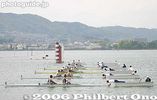
Starting line
|
|

8-man crew alumni in their 20s and 30s at starting line
|
|

Miss Nippon throw beans, but not very far.
|
|

Omi-Maiko appears in the song.
|
|

Ferris wheel from the Biwako Tower amusement park, now defunct. 琵琶湖タワー(廃墟)
|
|

Most races were not close.
|
|

The Toda Boat Course is a perfectly straight body of fresh water stretching over 2000 meters.
|
|

The boat is pencil-thin.
|
|

Page where "Water Lilies" is printed in the book. It is very likely that Chiaki found the song in this book, and decided to make his Japanese version. His signature is on the back of the book.
|
|

Waving the signal flag at a checkpoint to staff on shore.
|
|
|
|

Kimono beauties and beans do mix well.
|
|

Rolling with the waves
|
|
|

Kobe Univ. women rowers
|
|

Rinsing the oars.
|
|
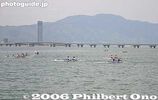
Two-man boat race
|
|

Kyodai alumni in their 20s and 30s
|
|

Women in kimono is a must on Setsubun day.
|
|
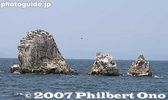
Okino-shiraishi Rocks, a favorite resting place for birds which turned the rocks white from bird droppings. Four rocks stand 80 meters deep in the lake. Out of the water, the tallest stands 14 meters high. 沖の白石
|
|

South of Biwako Ohashi Bridge.
|
|

The 250-meter course is very short, and each race ends within a minute or two.
|
|

Shiga Univ. cox at Toda Boat Course
|
|
|
|

Cheering/coaching from bicycle
|
|
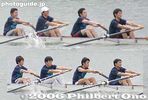
Kyodai alumni in their 20s and 30s
|
|

Minor female idols also on hand to throw beans.
|
|

So what does "Coral shrine" mean in the song? (There's no coral in the lake.) "I think it just refers to a beautiful place..." 「珊瑚の宮」はどういう意味?
|
|

Rowing past the Ukimido Floating Temple in Katata. 堅田 浮御堂(近江八景)
|
|

Finish line. In the background is the Kyoto University Rowing Club's boat house.
|
|

Shiga University women rowers
|
|
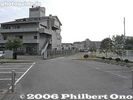
Entrance and road to the rowing clubhouse
|
|

Cheering/coaching on foot
|
|
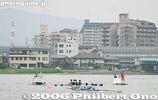
One of the main events, the 4-man boat race between Todai and Kyodai on a 3200-meter course.
|
|

節分会に吉井怜、三津谷葉子、福下恵美が豆まく
|
|

We landed on Chikubushima for about an hour. Jamie and Megan also sang in English in front of the Verse 4 song monument.
|
|

Ukimido Floating Temple, one of the Eight Views of Omi (Omi Hakkei). 堅田 浮御堂(近江八景)
|
|
|
|
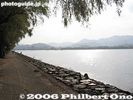
Near the rowing club is the Lake Biwa Rowing Course where regattas are held. 滋賀県立琵琶湖漕艇場
|
|
|

Todai's 4-man crew in the lead
|
|

Bikini idols Yoshii Rei, Mitsuya Yoko, and Fukushita Megumi throwing beans on Setsubun
|
|

Jamie and Megan Thompson sing in English in front of the Verse 4 song monument, Chikubushima. Next time we need to have an amplifier.
|
|

Mt. Hiei 比叡山
|
|

The race had to be stopped for a few minutes each time this cruise boat passed by.
|
|
|
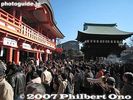
After the first bean-throwing session.
|
|

Awards ceremony
|
|

Kyodai's 4-man crew try to keep up
|
|

Jamie and Megan Thompson sing in English in front of the Verse 4 song monument, Chikubushima. They sang up to Verse 4. ジェイミーとメゲン・トンプソン姉妹が歌う
|
|

Omi-Fuji (Mt. Mikami) and Karasuma Peninsula. 近江富士(三上山)と烏丸半島
|
|

The Lake Biwa rowing Song CD was also sold.
|
|

Shiga Univ. banners
|
|

Verse 2 Song Monument, Omi-Maiko (Omatsu). On the lake shore in Omi-Maiko (Omatsu) behind Hotel Biwa Lake Otsuka. Built in March 1989. 二番の歌碑。近江舞子(ホテル琵琶レイクオーツカの前)Pine trees are very green, on sands very white.
Omatsugasato is, a young maiden's home.
Bush of red camellia, hides her teary face.
She's weeping o'er a lost love, much too short to last.
Matsu wa midori ni, suna shiroki
Omatsugasato no, otomego wa
Akai tsubaki no, morikage ni
Hakanai koi ni, naku toka ya
松は緑に 砂白き
雄松が里の 乙女子は
赤い椿の 森蔭に
|
|

YouTube video of the song Hitsuji-gusa (Water Lilies) by a choir called Koai Gassho no Kai (小合合唱の会) performing at a memorial gathering on the anniversary of Chiaki’s death in Feb. 2013 at Chiaki’s birth home.Video uploaded by Ichii Yasuzo in Niigata.
|
|
|

Boat landing
|
|

Mihogasaki harbor, Otsu. The arrow points to the boat house where Oguchi Taro and crew departed for their rowing trips.Mihogasaki is accessible by bus from Otsu Station. Or just walk west from Hama-Otsu. This is also where water from the lake is drawn into the Biwako Canal's first canal which feeds water to Kyoto.
|
|

Old photo of Verse 2 Song Monument in Omi-Maiko. The tree was cut down and lyrics later painted white.
|
|

Todai's 4-man crew rowing
|
|

The man holds the 90th Anniversary tour sign as a guide for the tour guests.
|
|

She is the cox sitting at the rear and controlling the rudder with a pair of strings. コックス
|
|
|
|

Only one bridge (for pedestrians only) spans over the course at the 500-meter line.
|
|

Imazu Exhibition, May 16 - June 25, 2006 at Biwako Shuko no Uta Shiryokan, Takashima, Shiga. Photo exhibition poster.
|
|
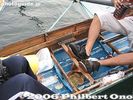
Lots of putty line the seams.
|
|
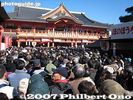
Crowd waits for another bean-throwing session
|
|
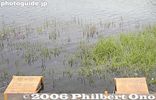
Temporary boat landing
|
|

Kyodai's 4-man crew rowing
|
|

Getting back on the boat. Little over a hundred people came on this cruise. If people knew it was gonna be such a beautiful day during this rainy season, more would have certainly come.
|
|

The Lake Biwa rowing Song CD was also sold during the regatta which lasted from 9 am to 4 pm.
|
|
|

Biwako Shuko no Uta Shiryokan song museum, in Imazu, Shiga 琵琶湖周航の歌資料館
|
|

Verse 2 monument is on the lake shore, in front of Hotel Biwa Lake Otsuka, near what appears to be a boat pier. Short walk from Omi-Maiko Station.Directions: Near Omi-Maiko Station on the JR Kosei Line. After exiting the station, walk left toward Kitahama. Then get to the lake shore and walk along the lakeshore road until you see the monument under a large tree right on the shore. It is in front of Hotel Biwa Lake Otsuka.
|
|
| 1196 files on 5 page(s) |
1 |
 |
 |
|